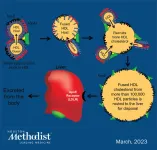(Press-News.org) Robots can be useful as mental wellbeing coaches in the workplace – but perception of their effectiveness depends in large part on what the robot looks like.
Researchers from the University of Cambridge carried out a study in a tech consultancy firm using two different robot wellbeing coaches, where 26 employees participated in weekly robot-led wellbeing sessions for four weeks. Although the robots had identical voices, facial expressions, and scripts for the sessions, the robots’ physical appearance affected how participants interacted with it.
Participants who did their wellbeing exercises with a toy-like robot said that they felt more of a connection with their ‘coach’ than participants who worked with a humanoid-like robot. The researchers say that perception of robots is affected by popular culture, where the only limit on what robots can do is the imagination. When faced with a robot in the real world however, it often does not live up to expectations.
Since the toy-like robot looks simpler, participants may have had lower expectations and ended up finding the robot easier to talk connect with. Participants who worked with the humanoid robot found that their expectations didn’t match reality, since the robot was not capable of having interactive conversations.
Despite the differences between expectations and reality, the researchers say that their study shows that robots can be a useful tool to promote mental wellbeing in the workplace. The results will be reported today (15 March) at the ACM/IEEE International Conference on Human-Robot Interaction in Stockholm.
The World Health Organization recommends that employers take action to promote and protect mental wellbeing at work, but the implementation of wellbeing practices is often limited by a lack of resources and personnel. Robots have shown some early promise for helping address this gap, but most studies on robots and wellbeing have been conducted in a laboratory setting.
“We wanted to take the robots out of the lab and study how they might be useful in the real world,” said Dr Micol Spitale, the paper’s first author.
The researchers collaborated with local technology company Cambridge Consultants to design and implement a workplace wellbeing programme using robots. Over the course of four weeks, employees were guided through four different wellbeing exercises by one of two robots: either the QTRobot (QT) or the Misty II robot (Misty).
The QT is a childlike humanoid robot and roughly 90cm tall, while Misty is a 36cm tall toy-like robot. Both robots have screen faces that can be programmed with different facial expressions.
“We interviewed different wellbeing coaches and then we programmed our robots to have a coach-like personality, with high openness and conscientiousness,” said co-author Minja Axelsson. “The robots were programmed to have the same personality, the same facial expressions and the same voice, so the only difference between them was the physical robot form.”
Participants in the experiment were guided through different positive psychology exercises by a robot in an office meeting room. Each session started with the robot asking participants to recall a positive experience or describe something in their lives they were grateful for, and the robot would ask follow-up questions. After the sessions, participants were asked to assess the robot with a questionnaire and an interview. Participants did one session per week for four weeks, and worked with the same robot for each session.
Participants who worked with the toy-like Misty robot reported that they had a better working connection with the robot than participants who worked with the child-like QT robot. Participants also had a more positive perception of Misty overall.
“It could be that since the Misty robot is more toy-like, it matched their expectations,” said Spitale. “But since QT is more humanoid, they expected it to behave like a human, which may be why participants who worked with QT were slightly underwhelmed.”
“The most common response we had from participants was that their expectations of the robot didn’t match with reality,” said Professor Hatice Gunes from Cambridge’s Department of Computer Science and Technology, who led the research. “We programmed the robots with a script, but participants were hoping there would be more interactivity. It’s incredibly difficult to create a robot that’s capable of natural conversation. New developments in large language models could really be beneficial in this respect.”
“Our perceptions of how robots should look or behave might be holding back the uptake of robotics in areas where they can be useful,” said Axelsson.
Although the robots used in the experiment are not as advanced as C-3PO or other fictional robots, participants still said they found the wellbeing exercises helpful, and that they were open to the idea of talking to a robot in future.
“The robot can serve as a physical reminder to commit to the practice of wellbeing exercises,” said Gunes. “And just saying things out loud, even to a robot, can be helpful when you’re trying to improve mental wellbeing.”
The team is now working to enhance the robot coaches’ responsiveness during the coaching practices and interactions.
The research was supported by the Engineering and Physical Sciences Research Council (EPSRC), part of UK Research and Innovation (UKRI). Hatice Gunes is a Staff Fellow of Trinity Hall, Cambridge.
END
Robots can help improve mental wellbeing at work – as long as they look right
2023-03-15
ELSE PRESS RELEASES FROM THIS DATE:
Knowing your ants from your anteaters: are wildlife documentaries showing us the ‘real’ natural world?
2023-03-15
Wildlife documentaries miss an opportunity to highlight the diversity of nature by focusing too much on mammals and birds, according to a new study.
In a new study published in People and Nature, researchers from the University of Cambridge have shown that while the production of wildlife documentaries has exploded over recent decades, they portray a biased view of the natural world around us.
Our natural world is under threat, from habitat and biodiversity loss, to high extinction rates. At the same time, there is a growing disconnect between people and nature, with children’s opportunities to experience the natural world diminishing.
Now more ...
Propeller advance paves way for quiet, efficient electric aviation
2023-03-15
Electrification is seen as having an important role to play in the fossil-free aviation of tomorrow. But electric aviation is battling a trade-off dilemma: the more energy-efficient an electric aircraft is, the noisier it gets. Now, researchers at Chalmers University of Technology, Sweden, have developed a propeller design optimisation method that paves the way for quiet, efficient electric aviation.
In recent years, electrification has been described as having an important role in reducing emissions from future aviation. Due to the challenges posed by longer ranges, interest is chiefly focused on electric propeller planes covering shorter distances. Propellers connected to ...
People of color have been largely underrepresented among authors published in the American Journal of Archaeology
2023-03-14
A new demographic survey of authorship in the American Journal of Archaeology (AJA) reveals that people of color have been largely underrepresented among the scholars published in the journal. The results of the survey, which also found that authors who are the children of people without advanced degrees were also underrepresented in the journal’s pages, are published in the paper “Demographic Dynamics of Publishing in the American Journal of Archaeology.” The study was conducted ...
Common cold gives children immunity against COVID-19
2023-03-14
During the pandemic, medical doctors and researchers noticed that children and adolescents infected with COVID-19 became less ill than adults. A possible explanation for this is that children already had a prior level of immunity to COVID-19 provided by memory T cells generated by common colds.
After studying unique blood samples from children taken before the pandemic, researchers from Karolinska Institutet in Sweden have now identified memory T cells that react to cells infected with SARS-CoV-2, the virus that causes COVID-19.
Four coronaviruses cause common colds
A possible explanation for this immunity in children is that they already had colds caused by one of the four coronaviruses ...
Researchers discover way to reverse infertility by reducing HDL cholesterol
2023-03-14
Houston Methodist scientists reversed infertility in sterile mice by reducing high-circulating cholesterol with a bacterial protein, showing further evidence that links high cholesterol to female infertility. This is a promising development, with one in every five women of childbearing age in the U.S. unable to get pregnant after trying for a year.
“We are working with a protein, called serum opacity factor, with unique characteristics,” said Corina Rosales, Ph.D., assistant research professor of molecular biology in medicine with the Houston Methodist ...
UK HealthCare’s Transplant Center celebrates 500th lung transplant
2023-03-14
LEXINGTON, Ky. (March 14, 2023) — The lung transplant team at UK HealthCare’s Transplant Center recently celebrated a major milestone, performing the 500th lung transplant since the lung transplant program was founded in 1991.
“This is an impressive milestone, and our whole staff — physicians, surgeons, nurse practitioners, nurse coordinators, pharmacists, nutritionists, social workers, therapists and support staff — should be very proud of their success,” said Sravanthi Nandavaram, M.D., medical director of the Lung Transplant Program. ...
How neuroimaging can be better utilized to yield diagnostic information about individuals
2023-03-14
Since the development of functional magnetic resonance imaging in the 1990s, the reliance on neuroimaging has skyrocketed as researchers investigate how fMRI data from the brain at rest, and anatomical brain structure itself, can be used to predict individual traits, such as depression, cognitive decline, and brain disorders.
Brain imaging has the potential to reveal the neural underpinnings of many traits, from disorders like depression and chronic widespread pain to why one person has a better memory than another, and why some people’s memories are resilient as they age. But how reliable brain imaging is for detecting traits has been a subject of wide debate.
Prior research ...
NASA’s Webb Telescope captures rarely seen prelude to supernova
2023-03-14
The rare sight of a Wolf-Rayet star – among the most luminous, most massive, and most briefly detectable stars known – was one of the first observations made by NASA’s James Webb Space Telescope in June 2022. Webb shows the star, WR 124, in unprecedented detail with its powerful infrared instruments. The star is 15,000 light-years away in the constellation Sagittarius.
Massive stars race through their lifecycles, and only some of them go through a brief Wolf-Rayet phase before going supernova, making Webb’s detailed observations of this rare phase valuable to astronomers. Wolf-Rayet stars are in the process of casting off their outer layers, ...
Potential treatment target for drug-resistant epilepsy identified
2023-03-14
Researchers at Tufts University School of Medicine and colleagues have identified a small molecule that may help treat people with epilepsy whose condition has become resistant to the benzodiazepine drugs usually used in managing seizures. The research, conducted in laboratory cells and rodents, was published online March 7 in Cell Reports Medicine.
Uncontrolled epilepsy can lead to frequent and prolonged seizures lasting five minutes or more that can cause brain cell damage and even death. The condition affects an estimated 3.4 million people in the U.S. and millions more worldwide.
Epilepsy occurs ...
New model provides improved air-quality predictions in fire-prone areas
2023-03-14
UNIVERSITY PARK, Pa. — Globally, wildfires are becoming more frequent and destructive, generating a significant amount of smoke that can be transported thousands of miles, driving the need for more accurate air pollution forecasts. A team of Penn State researchers developed a deep learning model that provides improved predictions of air quality in wildfire-prone areas and can differentiate between wildfires and non-wildfires.
“As climate change continues to cause ecological changes and challenges, it is likely that wildfire ...





